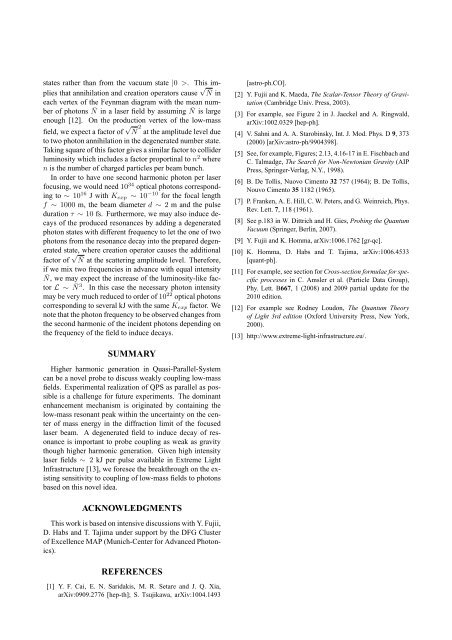Proceedings of International Conference on Physics in ... - KEK
Proceedings of International Conference on Physics in ... - KEK
Proceedings of International Conference on Physics in ... - KEK
Create successful ePaper yourself
Turn your PDF publications into a flip-book with our unique Google optimized e-Paper software.
states rather than from the vacuum state |0 >. This implies<br />
that annihilati<strong>on</strong> and creati<strong>on</strong> operators cause √ ¯ N <strong>in</strong><br />
each vertex <str<strong>on</strong>g>of</str<strong>on</strong>g> the Feynman diagram with the mean number<br />
<str<strong>on</strong>g>of</str<strong>on</strong>g> phot<strong>on</strong>s ¯ N <strong>in</strong> a laser field by assum<strong>in</strong>g ¯ N is large<br />
enough [12]. On the producti<strong>on</strong> vertex <str<strong>on</strong>g>of</str<strong>on</strong>g> the low-mass<br />
field, we expect a factor <str<strong>on</strong>g>of</str<strong>on</strong>g> √ 2<br />
N¯ at the amplitude level due<br />
to two phot<strong>on</strong> annihilati<strong>on</strong> <strong>in</strong> the degenerated number state.<br />
Tak<strong>in</strong>g square <str<strong>on</strong>g>of</str<strong>on</strong>g> this factor gives a similar factor to collider<br />
lum<strong>in</strong>osity which <strong>in</strong>cludes a factor proport<strong>in</strong>al to n 2 where<br />
n is the number <str<strong>on</strong>g>of</str<strong>on</strong>g> charged particles per beam bunch.<br />
In order to have <strong>on</strong>e sec<strong>on</strong>d harm<strong>on</strong>ic phot<strong>on</strong> per laser<br />
focus<strong>in</strong>g, we would need 10 34 optical phot<strong>on</strong>s corresp<strong>on</strong>d<strong>in</strong>g<br />
to ∼ 10 16 J with Kexp ∼ 10 −10 for the focal length<br />
f ∼ 1000 m, the beam diameter d ∼ 2 m and the pulse<br />
durati<strong>on</strong> τ ∼ 10 fs. Furthermore, we may also <strong>in</strong>duce decays<br />
<str<strong>on</strong>g>of</str<strong>on</strong>g> the produced res<strong>on</strong>ances by add<strong>in</strong>g a degenerated<br />
phot<strong>on</strong> states with different frequency to let the <strong>on</strong>e <str<strong>on</strong>g>of</str<strong>on</strong>g> two<br />
phot<strong>on</strong>s from the res<strong>on</strong>ance decay <strong>in</strong>to the prepared degenerated<br />
state, where creati<strong>on</strong> operator causes the additi<strong>on</strong>al<br />
factor <str<strong>on</strong>g>of</str<strong>on</strong>g> √ ¯ N at the scatter<strong>in</strong>g amplitude level. Therefore,<br />
if we mix two frequencies <strong>in</strong> advance with equal <strong>in</strong>tensity<br />
¯N, we may expect the <strong>in</strong>crease <str<strong>on</strong>g>of</str<strong>on</strong>g> the lum<strong>in</strong>osity-like factor<br />
L ∼ ¯ N 3 . In this case the necessary phot<strong>on</strong> <strong>in</strong>tensity<br />
may be very much reduced to order <str<strong>on</strong>g>of</str<strong>on</strong>g> 10 22 optical phot<strong>on</strong>s<br />
corresp<strong>on</strong>d<strong>in</strong>g to several kJ with the same Kexp factor. We<br />
note that the phot<strong>on</strong> frequency to be observed changes from<br />
the sec<strong>on</strong>d harm<strong>on</strong>ic <str<strong>on</strong>g>of</str<strong>on</strong>g> the <strong>in</strong>cident phot<strong>on</strong>s depend<strong>in</strong>g <strong>on</strong><br />
the frequency <str<strong>on</strong>g>of</str<strong>on</strong>g> the field to <strong>in</strong>duce decays.<br />
SUMMARY<br />
Higher harm<strong>on</strong>ic generati<strong>on</strong> <strong>in</strong> Quasi-Parallel-System<br />
can be a novel probe to discuss weakly coupl<strong>in</strong>g low-mass<br />
fields. Experimental realizati<strong>on</strong> <str<strong>on</strong>g>of</str<strong>on</strong>g> QPS as parallel as possible<br />
is a challenge for future experiments. The dom<strong>in</strong>ant<br />
enhancement mechanism is orig<strong>in</strong>ated by c<strong>on</strong>ta<strong>in</strong><strong>in</strong>g the<br />
low-mass res<strong>on</strong>ant peak with<strong>in</strong> the uncerta<strong>in</strong>ty <strong>on</strong> the center<br />
<str<strong>on</strong>g>of</str<strong>on</strong>g> mass energy <strong>in</strong> the diffracti<strong>on</strong> limit <str<strong>on</strong>g>of</str<strong>on</strong>g> the focused<br />
laser beam. A degenerated field to <strong>in</strong>duce decay <str<strong>on</strong>g>of</str<strong>on</strong>g> res<strong>on</strong>ance<br />
is important to probe coupl<strong>in</strong>g as weak as gravity<br />
though higher harm<strong>on</strong>ic generati<strong>on</strong>. Given high <strong>in</strong>tensity<br />
laser fields ∼ 2 kJ per pulse available <strong>in</strong> Extreme Light<br />
Infrastructure [13], we foresee the breakthrough <strong>on</strong> the exist<strong>in</strong>g<br />
sensitivity to coupl<strong>in</strong>g <str<strong>on</strong>g>of</str<strong>on</strong>g> low-mass fields to phot<strong>on</strong>s<br />
based <strong>on</strong> this novel idea.<br />
ACKNOWLEDGMENTS<br />
This work is based <strong>on</strong> <strong>in</strong>tensive discussi<strong>on</strong>s with Y. Fujii,<br />
D. Habs and T. Tajima under support by the DFG Cluster<br />
<str<strong>on</strong>g>of</str<strong>on</strong>g> Excellence MAP (Munich-Center for Advanced Phot<strong>on</strong>ics).<br />
REFERENCES<br />
[1] Y. F. Cai, E. N. Saridakis, M. R. Setare and J. Q. Xia,<br />
arXiv:0909.2776 [hep-th]; S. Tsujikawa, arXiv:1004.1493<br />
[astro-ph.CO].<br />
[2] Y. Fujii and K. Maeda, The Scalar-Tensor Theory <str<strong>on</strong>g>of</str<strong>on</strong>g> Gravitati<strong>on</strong><br />
(Cambridge Univ. Press, 2003).<br />
[3] For example, see Figure 2 <strong>in</strong> J. Jaeckel and A. R<strong>in</strong>gwald,<br />
arXiv:1002.0329 [hep-ph].<br />
[4] V. Sahni and A. A. Starob<strong>in</strong>sky, Int. J. Mod. Phys. D 9, 373<br />
(2000) [arXiv:astro-ph/9904398].<br />
[5] See, for example, Figures; 2.13, 4.16-17 <strong>in</strong> E. Fischbach and<br />
C. Talmadge, The Search for N<strong>on</strong>-Newt<strong>on</strong>ian Gravity (AIP<br />
Press, Spr<strong>in</strong>ger-Verlag, N.Y., 1998).<br />
[6] B. De Tollis, Nuovo Cimento 32 757 (1964); B. De Tollis,<br />
Nouvo Cimento 35 1182 (1965).<br />
[7] P. Franken, A. E. Hill, C. W. Peters, and G. We<strong>in</strong>reich, Phys.<br />
Rev. Lett. 7, 118 (1961).<br />
[8] See p.183 <strong>in</strong> W. Dittrich and H. Gies, Prob<strong>in</strong>g the Quantum<br />
Vacuum (Spr<strong>in</strong>ger, Berl<strong>in</strong>, 2007).<br />
[9] Y. Fujii and K. Homma, arXiv:1006.1762 [gr-qc].<br />
[10] K. Homma, D. Habs and T. Tajima, arXiv:1006.4533<br />
[quant-ph].<br />
[11] For example, see secti<strong>on</strong> for Cross-secti<strong>on</strong> formulae for specific<br />
processes <strong>in</strong> C. Amsler et al. (Particle Data Group),<br />
Phy. Lett. B667, 1 (2008) and 2009 partial update for the<br />
2010 editi<strong>on</strong>.<br />
[12] For example see Rodney Loud<strong>on</strong>, The Quantum Theory<br />
<str<strong>on</strong>g>of</str<strong>on</strong>g> Light 3rd editi<strong>on</strong> (Oxford University Press, New York,<br />
2000).<br />
[13] http://www.extreme-light-<strong>in</strong>frastructure.eu/.













